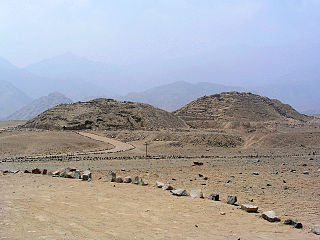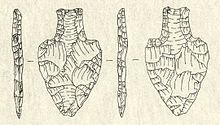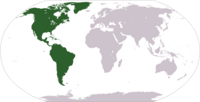
The Clovis culture is an archaeological culture from the Paleoindian period of North America, spanning around 13,050 to 12,750 years Before Present (BP). The type site is Blackwater Draw locality No. 1 near Clovis, New Mexico, where stone tools were found alongside the remains of Columbian mammoths in 1929. Clovis sites have been found across North America. The most distinctive part of the Clovis culture toolkit are Clovis points, which are projectile points with a fluted, lanceolate shape. Clovis points are typically large, sometimes exceeding 10 centimetres (3.9 in) in length. These points were multifunctional, also serving as cutting tools. Other stone tools used by the Clovis culture include knives, scrapers, and bifacial tools, with bone tools including beveled rods and shaft wrenches, with possible ivory points also being identified. Hides, wood, and natural fibers may also have been utilized, though no direct evidence of this has been preserved. Clovis artifacts are often found grouped together in caches where they had been stored for later retrieval, and over 20 Clovis caches have been identified.

Cahal Pech is a Maya site located near the town of San Ignacio in the Cayo District of Belize. The site was a palatial, hilltop home for an elite Maya family, and though the most major construction dates to the Classic period, evidence of continuous habitation has been dated to as far back as 1200 BCE during the Early Middle Formative period, making Cahal Pech one of the oldest recognizably Maya sites in Western Belize.

Uxbenka is a pre-Columbian Mesoamerican archaeological site located in Belize's southernmost district of Toledo. An urban settlement of the pre-Columbian Maya, it is the earliest-known Maya polity in the southern Belizean lowlands, with evidence of occupation dating to the Early Classic period of Mesoamerican chronology.

The Pre-Columbian Belize history is the period from initial indigenous presence, across millennia, to the first contacts with Europeans - the Pre-Columbian or before Columbus period - that occurred on the region of the Yucatán Peninsula that is present day Belize.
Cuello is a Maya archaeological site in northern Belize. The site is that of a farming village with a long occupational history. It was originally dated to 2000 BC, but these dates have now been corrected and updated to around 1200 BC. Its inhabitants lived in pole-and-thatch houses that were built on top of low plaster-coated platforms. The site contains residential groups clustered around central patios. It also features the remains of a steam bath dating to approximately 900 BC, making it the oldest steam bath found to date in the Maya lowlands. Human burials have been associated with the residential structures; the oldest have no surviving burial relics, but from 900 BC onwards, they were accompanied by offerings of ceramic vessels.

Grace Bank, formerly Barcadares, is an unincorporated hamlet 33 miles up the Belize River. It was the second settlement founded by the first English settlers of present-day Belize. It was settled in the 1650s, relocated in 1760, and resettled in 1853.
Colha, Belize is a Maya archaeological site located in northern portion of the country, about 52 km. north of Belize City, near the town of Orange Walk. The site is one of the earliest in the Maya region and remains important to the archaeological record of the Maya culture well into the Postclassic Period. According to Palma Buttles, “Archaeological evidence from Colha allows for the interpretation occupation from the Early Preceramic (3400-1900B.C.) to Middle Postclassic with population peaks occurring in the Late Preclassic and again in the Late Classic ”. These peaks in population are directly related to the presence of stone tool workshops at the site. Colha's proximity to an important source of high quality chert that is found in the Cenozoic limestone of the region and well traveled trade routes was utilized by the inhabitants to develop a niche in the Maya trade market that may have extended to the Greater Antilles. During the Late Preclassic and Late Classic periods, Colha served as a primary supplier of worked stone tools for the region. It has been estimated that the 36 workshops at Colha produced nearly 4 million chert and obsidian tools and eccentrics that were dispersed throughout Mesoamerica during the Maya era. This made it an important player in the trade of essential good throughout the area.
Baking Pot is a Maya archaeological site located in the Belize River Valley on the southern bank of the river, northeast of modern-day town of San Ignacio in the Cayo District of Belize; it is 6 kilometres (3.7 mi) downstream from the Barton Ramie and Lower Dover archaeological sites. Baking Pot is associated with an extensive amount of research into Maya settlements, community-based archaeology, and of agricultural production; the site possesses lithic workshops, and possible evidence of cash-cropping cacao as well as a long occupation from the Preclassic through to the Postclassic period.

The Gault archaeological site is an extensive, multicomponent site located in Florence, Texas, United States on the Williamson-Bell County line along Buttermilk Creek about 250 meters upstream from the Buttermilk Creek complex. It bears evidence of human habitation for at least 20,000 years, making it one of the few archaeological sites in the Americas at which compelling evidence has been found for human occupation dating to before the appearance of the Clovis culture. Archaeological material covers about 16 hectares with a depth of up to 3 meters in places. About 30 incised stones from the Clovis period engraved with geometric patterns were found there as well as others from periods up to the Early Archaic. Incised bone was also found.

The Andean preceramic refers to the early period of human occupation in the Andean area of South America that preceded the introduction of ceramics. This period is also called pre-ceramic or aceramic.
Marilyn Masson is a Maya archaeologist whose research has focused on social transformation and political economy of ancient Mesoamerican cultures in Mexico and Belize. She is a professor of Mesoamerican archaeology at the University at Albany, SUNY. She is a co-director of the PEMY project at the site of Mayapan in the Northern Yucutan Peninsula of Mexico.
Robert M. Rosenswig is a Mesoamerican archaeologist born Oct. 30, 1968 in Montreal, Canada. He earned a B.A at McGill University in 1994, an M.A. at the University of British Columbia in 1998 and Ph.D. in 2005 from Yale University. Rosenswig currently conducts research projects Mexico, Belize, and Costa Rica. His research explores the emergence of sociopolitical complexity and the development of agriculture.

The Archaic period, also known as the preceramic period, is a period in Mesoamerican chronology that begins around 8000 BCE and ends around 2000 BCE and is generally divided into Early, Middle, and Late Archaic periods. The period is preceded by the Paleoindian period and followed by the Preclassic period. Scholars have found it difficult to determine exactly when the Paleoindian period ends and the Archaic begins, but it is generally linked with changing climate associated with the transition from the Pleistocene to the Holocene epochs, and absence of extinct Pleistocene animals. It is also generally unclear when the Archaic period ends and the Preclassic period begins, though the appearance of pottery, large-scale agriculture, and villages signal the transition.
The Archaic period is traditionally viewed as a long, transitional interval between the hunter-gatherers of the Paleoindian period and the proliferation of agricultural villages in the Preclassic. This period is known for the domestication of major Mesoamerican crops, the development of agriculture, and the beginning of sedentism. The major developments in agriculture and sedentism during this time allowed for the rise of complex societies in the region. These developments were not uniform throughout Mesoamerica and often differed regionally.

Chetumal, or the Province of Chetumal, was a Postclassic Maya state of the Yucatan Peninsula, in the Maya Lowlands.

The Preceramic period of Belizean and Mesoamerican history began with the arrival of the first Palaeoindians during 20000 BC – 11000 BC, and ended with the Maya development of ceramics during 2000 BC – 900 BC.

The Preclassic or Formative period of Belizean, Maya, and Mesoamerican history began with the Maya development of ceramics during 2000 BC – 900 BC, and ended with the advent of Mayan monumental inscriptions in AD 250.

The Classic period of Belizean, Maya, and Mesoamerican history began with the advent of Mayan monumental inscriptions in AD 250, and ended with the decline of these inscriptions during the Classic Maya Collapse in AD 900.
Tzibte Yux, Tzib Te Yux, or Tzib'te Yux, is a Preceramic rock shelter and archaeological site in the Rio Blanco National Park, Toledo, Belize. It is thought to have been occupied by Palaeoindian settlers during 10500 BC – 6500 BC.

The periodisation of the history of Belize is the division of Belizean, Maya, and Mesoamerican history into named blocks of time, spanning the arrival of Palaeoindians to the present time. The pre-Columbian era is most often periodised by Mayanists, who often employ four or five periods to discuss history prior to the arrival of Spaniards. The Columbian era is most often periodised by historians, and less often by Mayanists, who often employ at least four periods to discuss history up to the present time.

The Maya Region is cultural, first order subdivision of Mesoamerica, located in the eastern half of the latter. Though first settled by Palaeoindians by at least 10,000 BC, it is now most commonly characterised and recognised as the territory which encompassed the Maya civilisation in the pre-Columbian era.












